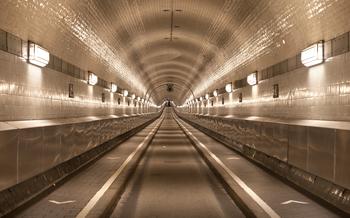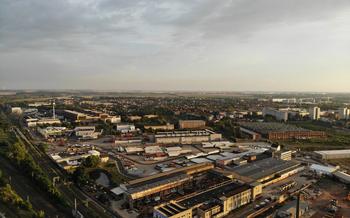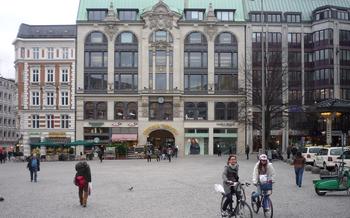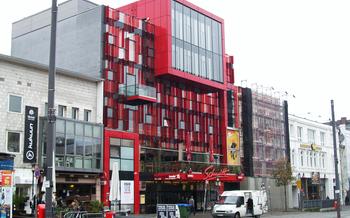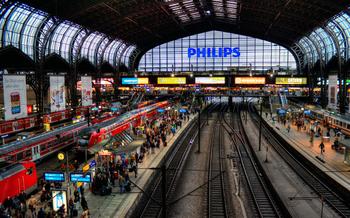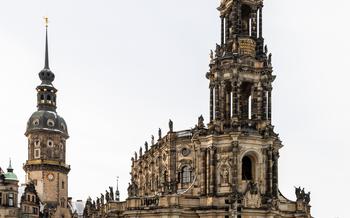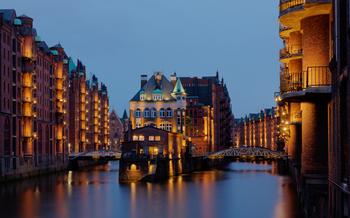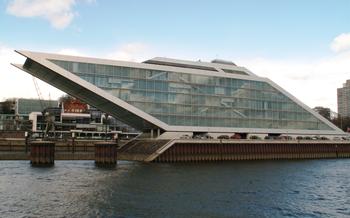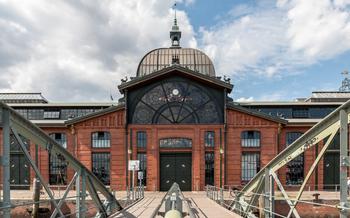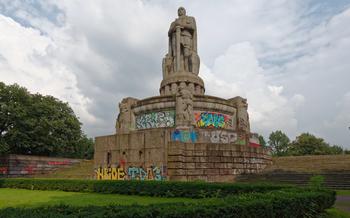
Museum Elbinsel Wilhelmsburg
- The Rebirth of Wilhelmsburg: From Industrial Hub to Cultural Hotspot
- Museum Elbinsel Wilhelmsburg: A Window into the Island's Past, Present, and Future
- A Journey through Time: Exploring the Museum's Permanent Exhibition
- Art, Nature, and Community: The Wilhelmsburg Art Mile
- Wilhelmsburg's Diverse Food Scene: A Culinary Adventure
- Exploring the Island's Green Oasis: The Wilhelmsburg Island Park
- Unleashing Creativity: The Kulturzentrum Pumpwerk
- A Place for Innovation: The Energieberg Georgswerder
- The Wilhelmsburg Bridge: A Marvel of Engineering and Design
- Wilhelmsburg Rowing Club: A Sporting Tradition on the Elbe
- The Former Flak Towers: Relics of War, Symbols of Transformation
- Wilhelmsburg Citizens' Center: A Hub for Community Engagement
- The Island's Festivals: Celebrating Wilhelmsburg's Diversity
- Insider Tip: Discovering Hidden Gems off the Beaten Path
The Rebirth of Wilhelmsburg: From Industrial Hub to Cultural Hotspot
Wilhelmsburg, an island in the Elbe River, holds a significant place in Hamburg's history. Once a thriving industrial center, it faced challenges as industries declined. However, Wilhelmsburg underwent a remarkable transformation, emerging as a vibrant cultural hotspot.
The island's rich heritage is deeply intertwined with its industrial past. Shipyards, factories, and warehouses once dominated its landscape. However, with the decline of heavy industry, Wilhelmsburg faced economic and social challenges.
Recognizing the need for revitalization, the city of Hamburg embarked on a comprehensive redevelopment plan. The aim was to transform Wilhelmsburg into a thriving cultural and residential area while preserving its unique industrial character.
This ambitious project involved the establishment of cultural institutions, the development of green spaces, and the creation of new housing opportunities. The International Garden Show (IGS), held in 2013, played a pivotal role in showcasing Wilhelmsburg's transformation.
Today, Wilhelmsburg is a vibrant and diverse neighborhood, attracting visitors and residents alike. It has become a hub for art, culture, and innovation, while still retaining its industrial roots. The island offers a unique blend of history, nature, and creativity, making it a must-visit destination for anyone exploring Hamburg.
Museum Elbinsel Wilhelmsburg: A Window into the Island's Past, Present, and Future
Established in 2009, the Museum Elbinsel Wilhelmsburg is a captivating cultural institution that delves into the rich history, dynamic present, and promising future of the eponymous island. The museum's diverse collection encompasses artifacts, photographs, and interactive exhibits that offer visitors a comprehensive exploration of Wilhelmsburg's transformation from an industrial hub to a vibrant cultural hotspot.
Through its permanent exhibition, the museum guides visitors on a chronological journey through the island's evolution. Highlights include meticulously crafted shipyard models, multimedia presentations that bring historical events to life, and personal anecdotes that provide a human perspective on the island's transformation. Interactive elements, such as touchscreens and hands-on activities, engage visitors and encourage them to delve deeper into the island's fascinating story.
Beyond its permanent exhibition, the museum hosts temporary exhibitions and events that celebrate contemporary art and culture. These exhibitions showcase the works of local, national, and international artists, providing a platform for creative expression and fostering a dialogue between the past and the present. The museum's commitment to preserving and showcasing Wilhelmsburg's heritage while embracing contemporary artistic trends makes it a must-visit destination for anyone interested in the island's multifaceted identity.
A Journey through Time: Exploring the Museum's Permanent Exhibition
The Museum Elbinsel Wilhelmsburg's permanent exhibition takes visitors on a captivating journey through time, delving into the island's rich history, transformation, and aspirations for the future. Thematic sections guide visitors through the island's evolution, from its industrial roots to its current status as a vibrant cultural hub.
Highlights of the permanent exhibition include intricate shipyard models that showcase the island's shipbuilding heritage, interactive multimedia presentations that bring the island's past to life, and personal stories and anecdotes from former residents that offer a glimpse into the island's social fabric. Interactive elements, such as touchscreens and hands-on activities, engage visitors and encourage them to explore the island's history in a dynamic and immersive way.
Art, Nature, and Community: The Wilhelmsburg Art Mile
The Wilhelmsburg Art Mile is a unique initiative that connects cultural venues across the island, creating a vibrant hub for artistic expression and community engagement. Along this scenic route, visitors can discover a diverse range of art installations, sculptures, and murals that reflect the island's rich history and contemporary culture. The Art Mile celebrates the power of art to transform public spaces and foster a sense of place.
Notable highlights of the Art Mile include the "Peace Bell," a symbol of harmony and reconciliation, and the "Elbe Islands Sculpture Park," which features works by renowned artists such as Thomas Schütte and Ólafur Elíasson. Visitors can also explore the "Energieberg Georgswerder," a former waste disposal site transformed into a sustainable energy park with striking artistic interventions.
The Wilhelmsburg Art Mile offers opportunities for visitors to engage with local artists and participate in workshops, fostering a sense of community and creativity. The Mile also hosts regular events, exhibitions, and festivals that showcase the talents of emerging and established artists, making it a dynamic and ever-changing destination for art enthusiasts.
Through the Wilhelmsburg Art Mile, the island's unique character and artistic spirit come alive, inviting visitors to experience the transformative power of art in shaping a community's identity and fostering a vibrant cultural landscape.
Wilhelmsburg's Diverse Food Scene: A Culinary Adventure
Wilhelmsburg is a foodie's paradise, offering a diverse range of culinary experiences that cater to every taste and budget. From traditional German fare to international cuisine, the island's restaurants, cafes, and markets showcase the rich cultural tapestry that defines Wilhelmsburg.
At the heart of the island's culinary scene lies the Wilhelmsburg Market, a vibrant hub where locals and visitors alike come together to savor fresh produce, artisanal bread, and handmade cheeses. The market, held every Saturday, is a testament to the island's agricultural heritage and offers a glimpse into the local way of life.
For those seeking a taste of traditional German cuisine, the Gasthaus Elbterrasse, located on the banks of the Elbe River, serves up hearty dishes such as schnitzel, bratwurst, and sauerkraut, all accompanied by stunning views of the Hamburg skyline.
Wilhelmsburg's international culinary offerings are equally impressive. The island is home to a diverse array of restaurants serving everything from Italian pasta to Turkish kebabs and Japanese sushi. Whether you're in the mood for a quick bite or a leisurely dining experience, Wilhelmsburg has something to satisfy every craving.
Food plays a central role in fostering a sense of community on the island. The annual Wilhelmsburg Food Festival, held every summer, brings together local restaurants, food trucks, and street vendors to celebrate the island's culinary diversity. With live music, family-friendly activities, and a wide variety of food stalls, the festival is a must-attend event for food enthusiasts.
Exploring Wilhelmsburg's food scene is not just about satisfying your taste buds; it's also about immersing yourself in the island's vibrant culture and connecting with the local community. So, whether you're a foodie, a traveler, or simply looking for a unique dining experience, be sure to venture into Wilhelmsburg and discover the culinary delights that await.
Exploring the Island's Green Oasis: The Wilhelmsburg Island Park
Amidst the industrial heritage and cultural vibrancy of Wilhelmsburg, the Wilhelmsburg Island Park emerges as a tranquil oasis, offering a refuge from the urban hustle and a chance to reconnect with nature. This sprawling green space, covering over 100 hectares, serves as a vital lung for the city of Hamburg, providing residents and visitors alike with a sanctuary for relaxation, recreation, and environmental education.
The park boasts a diverse tapestry of landscapes, from lush meadows and serene forests to picturesque waterfronts along the Elbe River. Visitors can embark on leisurely walks or invigorating bike rides along the park's extensive network of trails, taking in the beauty of the natural surroundings and the panoramic views of the city skyline. Playgrounds and recreational areas are scattered throughout the park, inviting families to spend quality time outdoors, while designated barbecue spots offer opportunities for picnics and gatherings.
The Wilhelmsburg Island Park is not just a place for recreation but also a hub for environmental education and sustainability initiatives. The park features interactive exhibits and educational programs that raise awareness about local flora and fauna, the importance of biodiversity, and the impact of human activities on the environment. Visitors can learn about the park's ongoing conservation efforts and participate in hands-on activities that promote environmental stewardship.
Beyond its ecological significance, the park plays a crucial role in fostering a sense of community among Wilhelmsburg residents. It serves as a gathering place for events, festivals, and cultural activities, bringing people together to celebrate their shared heritage and create lasting memories. The Wilhelmsburg Island Park is a testament to the island's commitment to sustainability, community engagement, and the preservation of green spaces for future generations.
Unleashing Creativity: The Kulturzentrum Pumpwerk
The Kulturzentrum Pumpwerk is a vibrant cultural center housed in a former pumping station, embodying Wilhelmsburg's transformation from an industrial hub to a cultural hotspot. This unique venue is a testament to the island's ability to repurpose its past for a creative future.
The Kulturzentrum Pumpwerk is dedicated to promoting contemporary art, music, and theater, providing a platform for emerging and established artists to showcase their work. Its diverse program includes exhibitions, concerts, performances, and workshops, attracting a wide range of visitors from across Hamburg and beyond.
One of the highlights of the Kulturzentrum Pumpwerk is its annual "Pumpwerk Summer Festival," a month-long extravaganza featuring a variety of outdoor events, concerts, and performances. This festival brings the community together and showcases the best of Wilhelmsburg's creative energy.
Beyond its artistic offerings, the Kulturzentrum Pumpwerk also serves as a community gathering place, hosting events such as flea markets, workshops, and lectures. It is a hub for creative expression, fostering collaboration and dialogue among artists, residents, and visitors alike.
The Kulturzentrum Pumpwerk stands as a symbol of Wilhelmsburg's ongoing transformation, demonstrating how the island's industrial heritage can be reimagined as a vibrant cultural destination.
A Place for Innovation: The Energieberg Georgswerder
At the heart of Wilhelmsburg lies a remarkable symbol of innovation and sustainability—the Energieberg Georgswerder. This unique project combines waste management with energy production, creating a sustainable landmark that showcases Hamburg's commitment to a greener future.
The Energieberg's journey began as a landfill site in the 1960s. Over time, the site evolved into a waste-to-energy plant, harnessing the potential of waste to generate electricity and heat for the city. Today, the Energieberg stands as a testament to the power of innovation, transforming waste into a valuable resource.
Visitors to the Energieberg can embark on an educational and interactive journey. The site features exhibits that explain the waste-to-energy process, showcasing how everyday waste is converted into clean energy. Interactive displays allow visitors to explore the science behind renewable energy and its significance for the environment.
The Energieberg's commitment to sustainability extends beyond energy production. The site also incorporates green spaces, walking trails, and educational programs, fostering a greater understanding of environmental issues and the importance of responsible waste management.
As a symbol of Hamburg's dedication to sustainability, the Energieberg Georgswerder stands as an inspiring example of how innovation can drive positive change. Its educational and interactive exhibits make it a must-visit destination for anyone interested in renewable energy, waste management, and the pursuit of a greener future.
The Wilhelmsburg Bridge: A Marvel of Engineering and Design
The Wilhelmsburg Bridge, an architectural and engineering masterpiece, stands as a testament to human ingenuity and ambition. Completed in 2005, this cable-stayed bridge is a marvel of modern engineering, embodying the spirit of innovation that has defined Wilhelmsburg's transformation.
The bridge's design is a striking combination of strength and elegance. Its main span, stretching over 300 meters, is supported by a series of steel cables that fan out from two graceful pylons, creating a visually captivating silhouette against the backdrop of the Elbe River.
Beyond its aesthetic appeal, the Wilhelmsburg Bridge plays a crucial role in connecting Wilhelmsburg to the rest of Hamburg, symbolizing the island's integration into the city's urban fabric. The bridge's six lanes of traffic and a dedicated lane for cyclists and pedestrians ensure a seamless flow of movement, facilitating commuting, commerce, and social interactions between Wilhelmsburg and the mainland.
One of the most captivating aspects of the Wilhelmsburg Bridge is the panoramic views it offers to visitors. From the pedestrian walkway or the viewing platform atop one of the pylons, visitors can enjoy breathtaking vistas of the Elbe River, the port of Hamburg, and the city skyline. The ever-changing panorama, with ships gliding along the river, seagulls soaring overhead, and the cityscape evolving in the distance, creates a truly mesmerizing experience.
The Wilhelmsburg Bridge is more than just a bridge; it is a symbol of transformation, representing Wilhelmsburg's journey from an industrial hub to a vibrant cultural and residential district. The bridge's iconic status is a reminder of the island's resilience, its ability to adapt and evolve, and its emergence as a dynamic and integral part of Hamburg's urban landscape.
Wilhelmsburg Rowing Club: A Sporting Tradition on the Elbe
Wilhelmsburg's rich sporting heritage is embodied by the Wilhelmsburg Rowing Club, a renowned institution dedicated to promoting rowing and water sports in the Elbe region. Founded in 1883, the club has a long and illustrious history, having produced numerous champions and Olympians over the years.
Located on the banks of the Elbe River, the club offers a scenic and challenging environment for rowers of all levels. With its state-of-the-art facilities, including a modern boathouse and well-maintained rowing lanes, the club provides an ideal setting for training and competition.
Visitors to Wilhelmsburg can experience the excitement of rowing firsthand by joining the club's guided rowing tours. Led by experienced instructors, these tours offer a unique perspective of the island and its surroundings, allowing participants to explore hidden waterways and enjoy the tranquility of the Elbe River.
The Wilhelmsburg Rowing Club is not just a sporting institution; it is also a vibrant community hub that fosters camaraderie and teamwork among its members. The club regularly organizes social events, regattas, and competitions, providing opportunities for rowers to connect, share their passion for the sport, and celebrate their achievements.
Whether you are a seasoned rower looking for a challenging training environment or a curious visitor seeking a unique experience, the Wilhelmsburg Rowing Club welcomes you with open arms. Embrace the spirit of rowing and immerse yourself in the island's rich sporting tradition.
The Former Flak Towers: Relics of War, Symbols of Transformation
Wilhelmsburg is home to four former flak towers, imposing structures that served as air-raid shelters during World War II. These massive towers, constructed between 1943 and 1944, stand as somber reminders of the city's wartime past. After the war, the towers faced an uncertain future, as their size and design made them difficult to repurpose. However, through innovative thinking and community engagement, these relics of war have been transformed into symbols of renewal and resilience.
Today, the flak towers serve a variety of purposes, showcasing the island's ability to adapt and evolve. One tower has been converted into a residential building, providing unique living spaces with panoramic views of the city. Another tower houses a museum dedicated to the history of Wilhelmsburg, preserving and sharing the island's rich heritage. A third tower serves as a cultural venue, hosting exhibitions, concerts, and performances, bringing the community together through the arts. The fourth tower, a poignant reminder of the war, stands as a memorial, honoring the victims of the air raids and promoting peace and reconciliation.
The transformation of the flak towers is a testament to Wilhelmsburg's resilience and creativity. These once-ominous structures have been given new life, becoming symbols of hope, renewal, and the power of community to overcome adversity. Visitors to the island can explore these remarkable landmarks, gaining insights into Wilhelmsburg's history and its inspiring journey of transformation.
Wilhelmsburg Citizens' Center: A Hub for Community Engagement
At the heart of Wilhelmsburg lies the Citizens' Center, a vibrant hub dedicated to fostering community development and social cohesion. Established as a meeting point for the island's diverse population, the center offers a wide range of services, including counseling, education, and cultural events, all aimed at empowering residents and creating a sense of belonging.
The center's dedicated team of social workers, educators, and volunteers work tirelessly to address the needs of the community, providing support and guidance on various issues, from housing and employment to family matters and integration. By creating a welcoming and inclusive environment, the center has become a vital resource for Wilhelmsburg residents, helping them navigate challenges, build connections, and actively participate in shaping their community.
One of the center's key initiatives is the "Welcome to Wilhelmsburg" program, which offers newcomers to the island a warm reception and assistance in settling in. Through workshops, language classes, and cultural events, the program helps newcomers integrate into the community, learn about German culture, and access essential services.
The center also hosts regular events and activities that celebrate Wilhelmsburg's diversity and promote social cohesion. From international cooking classes and sports tournaments to art exhibitions and music concerts, these events provide opportunities for residents to come together, share their experiences, and forge new friendships.
The success of the Wilhelmsburg Citizens' Center is evident in the vibrant and inclusive community it has helped to create. By providing a platform for dialogue, collaboration, and mutual support, the center has empowered residents to take ownership of their community and work together to build a better future for Wilhelmsburg.
The Island's Festivals: Celebrating Wilhelmsburg's Diversity
Wilhelmsburg's vibrant culture and diverse community come alive during the island's numerous festivals throughout the year. These festivals offer a unique opportunity to immerse oneself in the island's spirit and experience its rich offerings.
One of the most popular festivals is the Wilhelmsburg Rowing Festival, held annually in June. This festival celebrates the island's strong rowing tradition and features exciting boat races, live music, and traditional food. Visitors can cheer on the rowers, enjoy the festive atmosphere, and learn more about the sport.
Another highlight is the Wilhelmsburg Island Festival, held in August. This family-friendly festival takes place on the banks of the Elbe River and offers a variety of activities for all ages. Visitors can enjoy live music and performances, browse local arts and crafts stalls, indulge in delicious food and drinks, and take part in fun workshops and games.
For those interested in art and culture, the Wilhelmsburg Art Festival is a must-attend event. Held annually in September, this festival showcases the island's thriving art scene, with exhibitions, workshops, performances, and installations by local and international artists. Visitors can explore the island's galleries, studios, and public spaces to discover a diverse range of artistic expressions.
These festivals are just a glimpse of the vibrant cultural scene that Wilhelmsburg has to offer. By participating in these events, visitors can not only experience the island's unique atmosphere but also contribute to its ongoing transformation and development.
Insider Tip: Discovering Hidden Gems off the Beaten Path
Beyond the well-known attractions, Wilhelmsburg offers a treasure trove of hidden gems waiting to be discovered by curious travelers. To truly immerse yourself in the island's unique character, venture off the beaten path and seek out these lesser-known spots.
One such hidden gem is the "Alte Schule Kirchdorf," a charming former schoolhouse now transformed into a vibrant cultural center. Here, you can attend art exhibitions, concerts, and workshops, or simply relax in the cozy café, surrounded by local artwork.
For a taste of Wilhelmsburg's industrial heritage, visit the "Hafenmuseum Hamburg," housed in a former shipyard building. This museum showcases the island's maritime past through interactive exhibits, historical artifacts, and stunning views of the Elbe River.
Nature enthusiasts will delight in exploring the "Inselpark Wilhelmsburg Ost," a hidden oasis of tranquility just a short walk from the bustling harbor. Wander through tranquil forests, spot rare bird species in the wetlands, and soak in the serene atmosphere of this urban nature reserve.
To experience Wilhelmsburg's vibrant street art scene, head to the "Graffitihalle Wilhelmsburg," an indoor graffiti gallery featuring works by local and international artists. Here, you can marvel at colorful murals, participate in workshops, and gain insights into the island's urban art culture.
For a unique shopping experience, visit the "Markthalle Wilhelmsburg," a vibrant indoor market showcasing a variety of local products, from fresh produce and artisanal cheeses to handmade crafts and vintage treasures. Engage with friendly vendors, sample local delicacies, and take home a piece of Wilhelmsburg's culinary heritage.
